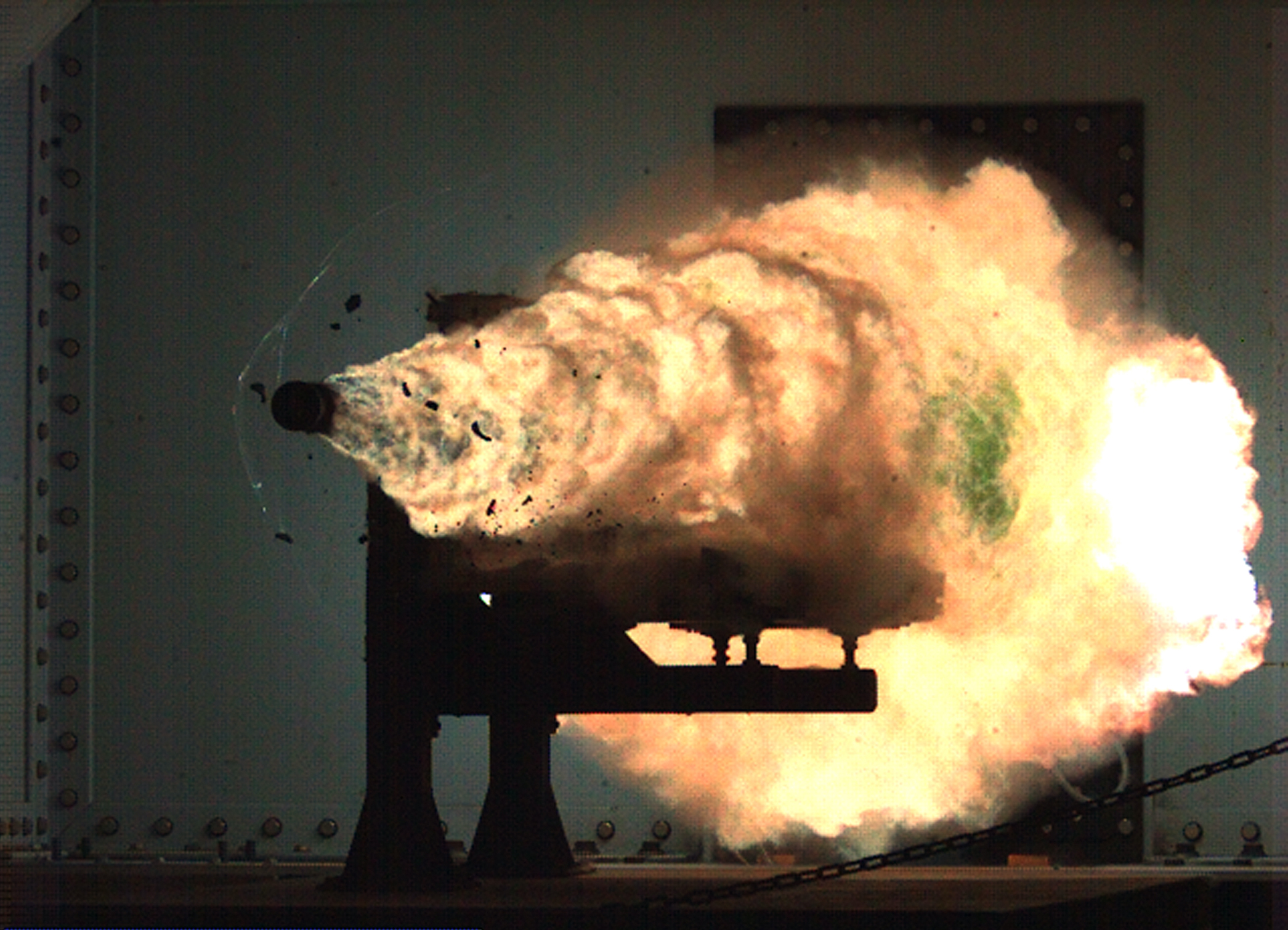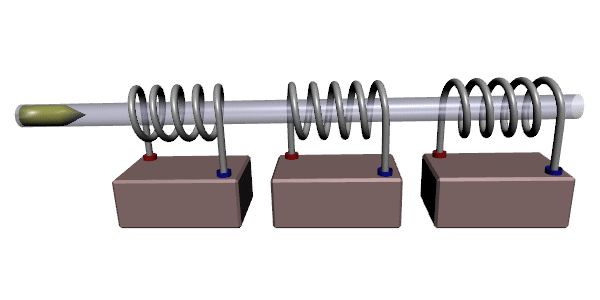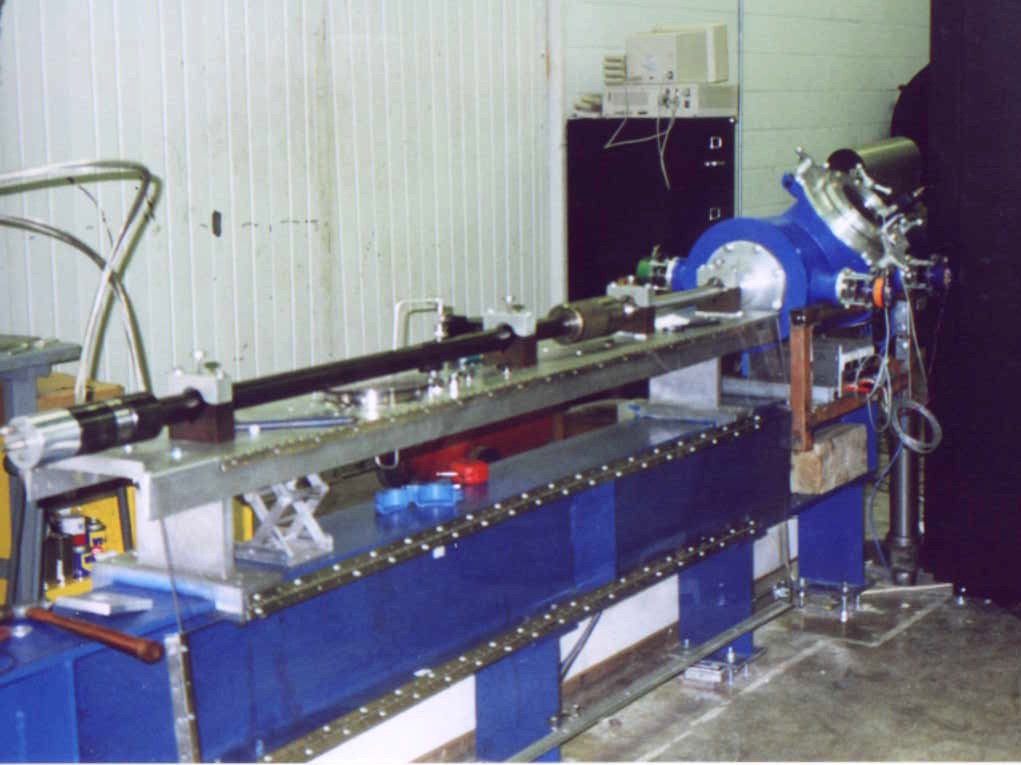|
Helical Railgun
Helical railguns are multi-turn railguns that reduce rail and brush current by a factor equal to the number of turns. Two rails are surrounded by a helical barrel and the projectile or re-usable carrier is cylindrical. The projectile is energized continuously by two brushes sliding along the rails, and two or more additional brushes on the projectile serve to energize and commute several windings of the helical barrel direction in front of and/or behind the projectile. The helical railgun is a cross between a railgun and a coilgun. They do not currently exist in a practical, usable form. A helical railgun was built at MIT in 1980 and was powered by several banks of, for the time, large capacitors (approximately 4 farads). It was about 3 meters long, consisting of 2 meters of accelerating coil and 1 meter of decelerating coil. It was able to launch a glider or projectile about 500 meters. See also *Railgun *Plasma railgun *Coilgun *Mass driver *Ram accelerator *Light-gas gun *Electr ... [...More Info...] [...Related Items...] OR: [Wikipedia] [Google] [Baidu] |
Railgun
A railgun or rail gun is a linear motor device, typically designed as a weapon, that uses electromagnetic force to launch high velocity projectiles. The projectile normally does not contain explosives, instead relying on the projectile's high speed, mass, and kinetic energy to inflict damage. The railgun uses a pair of parallel conductors (rails), along which a sliding armature is accelerated by the electromagnetic effects of a current that flows down one rail, into the armature and then back along the other rail. It is based on principles similar to those of the homopolar motor. As of 2020, railguns have been researched as weapons utilizing electromagnetic forces to impart a very high kinetic energy to a projectile (e.g. APFSDS) rather than using conventional propellants. While explosive-powered military guns cannot readily achieve a muzzle velocity of more than ≈, railguns can readily exceed . For a similar projectile, the range of railguns may exceed that of conventional ... [...More Info...] [...Related Items...] OR: [Wikipedia] [Google] [Baidu] |
Helix
A helix () is a shape like a corkscrew or spiral staircase. It is a type of smooth space curve with tangent lines at a constant angle to a fixed axis. Helices are important in biology, as the DNA molecule is formed as two intertwined helices, and many proteins have helical substructures, known as alpha helices. The word ''helix'' comes from the Greek word ''ἕλιξ'', "twisted, curved". A "filled-in" helix – for example, a "spiral" (helical) ramp – is a surface called '' helicoid''. Properties and types The ''pitch'' of a helix is the height of one complete helix turn, measured parallel to the axis of the helix. A double helix consists of two (typically congruent) helices with the same axis, differing by a translation along the axis. A circular helix (i.e. one with constant radius) has constant band curvature and constant torsion. A '' conic helix'', also known as a ''conic spiral'', may be defined as a spiral on a conic surface, with the distance to the ape ... [...More Info...] [...Related Items...] OR: [Wikipedia] [Google] [Baidu] |
Coilgun
A coilgun, also known as a Gauss rifle, is a type of mass driver consisting of one or more coils used as electromagnets in the configuration of a linear motor that accelerate a ferromagnetic or conducting projectile to high velocity. In almost all coilgun configurations, the coils and the gun barrel are arranged on a common axis. A coilgun is not a rifle as the barrel is smoothbore (not rifled). The name "Gauss" is in reference to Carl Friedrich Gauss, who formulated mathematical descriptions of the magnetic effect used by magnetic accelerator cannons. Coilguns generally consist of one or more coils arranged along a barrel, so the path of the accelerating projectile lies along the central axis of the coils. The coils are switched on and off in a precisely timed sequence, causing the projectile to be accelerated quickly along the barrel via magnetic forces. Coilguns are distinct from railguns, as the direction of acceleration in a railgun is at right angles to the central axi ... [...More Info...] [...Related Items...] OR: [Wikipedia] [Google] [Baidu] |
Farad
The farad (symbol: F) is the unit of electrical capacitance, the ability of a body to store an electrical charge, in the International System of Units (SI). It is named after the English physicist Michael Faraday (1791–1867). In SI base units 1 F = 1 kg−1⋅ m−2⋅ s4⋅ A2. Definition The capacitance of a capacitor is one farad when one coulomb of charge changes the potential between the plates by one volt. Equally, one farad can be described as the capacitance which stores a one-coulomb charge across a potential difference of one volt. The relationship between capacitance, charge, and potential difference is linear. For example, if the potential difference across a capacitor is halved, the quantity of charge stored by that capacitor will also be halved. For most applications, the farad is an impractically large unit of capacitance. Most electrical and electronic applications are covered by the following SI prefixes: *1 mF (millifarad, one thousandth ... [...More Info...] [...Related Items...] OR: [Wikipedia] [Google] [Baidu] |
Railgun
A railgun or rail gun is a linear motor device, typically designed as a weapon, that uses electromagnetic force to launch high velocity projectiles. The projectile normally does not contain explosives, instead relying on the projectile's high speed, mass, and kinetic energy to inflict damage. The railgun uses a pair of parallel conductors (rails), along which a sliding armature is accelerated by the electromagnetic effects of a current that flows down one rail, into the armature and then back along the other rail. It is based on principles similar to those of the homopolar motor. As of 2020, railguns have been researched as weapons utilizing electromagnetic forces to impart a very high kinetic energy to a projectile (e.g. APFSDS) rather than using conventional propellants. While explosive-powered military guns cannot readily achieve a muzzle velocity of more than ≈, railguns can readily exceed . For a similar projectile, the range of railguns may exceed that of conventional ... [...More Info...] [...Related Items...] OR: [Wikipedia] [Google] [Baidu] |
Plasma Railgun
A plasma railgun is a linear accelerator which, like a projectile railgun, uses two long parallel electrodes to accelerate a "sliding short" armature. However, in a plasma railgun, the armature and ejected projectile consists of plasma, or hot, ionized, gas-like particles, instead of a solid slug of material. Scientific plasma railguns are typically operated in vacuum and not at air pressure. They are of value because they produce muzzle velocities of up to several hundreds of kilometers per second. Because of this, these devices have applications in magnetic confinement fusion (MCF), magneto-inertial fusion (MIF), high energy density physics research (HEDP), laboratory astrophysics, and as a plasma propulsion engine for spacecraft. Theory Plasma railguns appear in two principal topologies, linear and coaxial. Linear railguns consist of two flat plate electrodes separated by insulating spacers and accelerate sheet armatures. Coaxial railguns accelerate toroidal plasma armatur ... [...More Info...] [...Related Items...] OR: [Wikipedia] [Google] [Baidu] |
Coilgun
A coilgun, also known as a Gauss rifle, is a type of mass driver consisting of one or more coils used as electromagnets in the configuration of a linear motor that accelerate a ferromagnetic or conducting projectile to high velocity. In almost all coilgun configurations, the coils and the gun barrel are arranged on a common axis. A coilgun is not a rifle as the barrel is smoothbore (not rifled). The name "Gauss" is in reference to Carl Friedrich Gauss, who formulated mathematical descriptions of the magnetic effect used by magnetic accelerator cannons. Coilguns generally consist of one or more coils arranged along a barrel, so the path of the accelerating projectile lies along the central axis of the coils. The coils are switched on and off in a precisely timed sequence, causing the projectile to be accelerated quickly along the barrel via magnetic forces. Coilguns are distinct from railguns, as the direction of acceleration in a railgun is at right angles to the central axi ... [...More Info...] [...Related Items...] OR: [Wikipedia] [Google] [Baidu] |
Mass Driver
A mass driver or electromagnetic catapult is a proposed method of non-rocket spacelaunch which would use a linear motor to accelerate and catapult payloads up to high speeds. Existing and contemplated mass drivers use coils of wire energized by electricity to make electromagnets, though a rotary mass driver has also been proposed. Sequential firing of a row of electromagnets accelerates the payload along a path. After leaving the path, the payload continues to move due to momentum. Although any device used to propel a ballistic payload is technically a mass driver, in this context a mass driver is essentially a coilgun that magnetically accelerates a package consisting of a magnetizable holder containing a payload. Once the payload has been accelerated, the two separate, and the holder is slowed and recycled for another payload. Mass drivers can be used to propel spacecraft in three different ways: A large, ground-based mass driver could be used to launch spacecraft away from E ... [...More Info...] [...Related Items...] OR: [Wikipedia] [Google] [Baidu] |
Ram Accelerator
A ram accelerator is a device for accelerating projectiles or just a single projectile to extremely high speeds using jet-engine-like propulsion cycles based on ramjet or scramjet combustion processes. It is thought to be possible to achieve non-rocket spacelaunch with this technology. It consists of a long tube (barrel) filled with a mixture of combustible gases with a frangible diaphragm at either end to contain the gases. The projectile is fired by another means (e.g., a light-gas gun or railgun) supersonically through the first diaphragm into the tube. Then the projectile burns the gases as fuel, because it is shaped like a ramjet or scramjet core, and accelerates under jet propulsion. Other physics come into play at higher velocities. Description In a normal ramjet, air is compressed between a spike-shaped centerbody and an outer cowling, fuel is added and burned, and high speed exhaust gases are expanded supersonically out of the nozzle to generate thrust. In a ram accel ... [...More Info...] [...Related Items...] OR: [Wikipedia] [Google] [Baidu] |
Light-gas Gun
The light-gas gun is an apparatus for physics experiments. It is a highly specialized gun designed to generate extremely high velocities. It is usually used to study high-speed impact phenomena (hypervelocity research), such as the formation of impact craters by meteorites or the erosion of materials by micrometeoroids. Some basic material research relies on projectile impact to create high pressure; such systems are capable of forcing liquid hydrogen into a metallic state. Operation A light-gas gun works on the same principle as a spring piston airgun. A large-diameter piston is used to force a gaseous working fluid through a smaller-diameter barrel containing the projectile to be accelerated. This reduction in diameter acts as a lever, increasing the speed while decreasing the pressure. In an airgun, the large piston is powered by a spring or compressed air, and the working fluid is atmospheric air. In a light-gas gun, the piston is powered by a chemical reaction (usually g ... [...More Info...] [...Related Items...] OR: [Wikipedia] [Google] [Baidu] |
Electrothermal-chemical Technology
Electrothermal-chemical (ETC) technology is an attempt to increase accuracy and muzzle energy of future tank, artillery, and close-in weapon system guns by improving the predictability and rate of expansion of propellants inside the barrel. An electrothermal-chemical gun uses a plasma cartridge to ignite and control the ammunition's propellant, using electrical energy to trigger the process. ETC increases the performance of conventional solid propellants, reduces the effect of temperature on propellant expansion and allows for more advanced, higher density propellants to be used. The technology has been under development since the mid-1980s and at present is actively being researched in the United States by the Army Research Laboratory, Sandia National Laboratories and defense industry contractors, including FMC Corporation, General Dynamics Land Systems, Olin Ordnance, and Soreq Nuclear Research Center. It is possible that electrothermal-chemical gun propulsion will be an in ... [...More Info...] [...Related Items...] OR: [Wikipedia] [Google] [Baidu] |
Henry Kolm
Henry Herbert Kolm (September 9, 1924 in Vienna – July 29, 2010 in Concord, Massachusetts) was an American physicist associated with Massachusetts Institute of Technology (MIT) for many years, with extensive expertise in high-power magnets and strong magnetic fields. Senior Scientist at MIT Henry Kolm was a long-time associate of the Francis Bitter National Magnet Laboratory. As such, his goal was the creation and application of high magnetic fields. He has also worked on magnetic levitation for transit applications and on various electromagnetic space launch concepts including the MIT Mass Driver 1 (1976–77), continuing into the 1980s. Over the years, he worked with Francis Bitter, Gerard K. O'Neill, and Eric Drexler, among others. Comment regarding interrogation methods In an op-ed column, Frank Rich quoted Kolm as saying, "We got more information out of a German general with a game of chess or Ping-Pong than they do today, with their torture", in recounting his ... [...More Info...] [...Related Items...] OR: [Wikipedia] [Google] [Baidu] |




